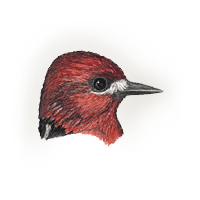|
Field
Guide IDs: BREEDING:
Aspen-pine assoc
and conif forest, including humid coastal lowlands.
N populations breed at lower elevations than s
populations. ? broods. DISPLAYS:
Not well known, but
probably similar to Yellow-bellied
Sapsucker's. NEST:
At low elevation
prefers live decid tree (alder, cottonwood, aspen);
at higher elevations fir, riparian alder or willow
preferred. Decid snags also used. Lined with
chips. EGGS:
White. 1.0" (24
mm). DIET:
Esp ants; drill and
strip bark to produce perennial sap wells.
Fledglings taught sapsucking while clinging to nest
tree, but still fed insects, fruit. CONSERVATION:
Winters s to n
Baja. NOTES:
Warblers,
hummingbirds, other species use sap wells.
Hybridization between Red-breasted and Red-naped
Sapsuckers restricted to narrow zone in s c OR, n e
CA, and along CA-NV border to s NV; hybrid zone
stable because hybrids are less
successful. Uncommon migrant
and winter resident throughout campus. Excavates
wells in eucalyptus, coast live oaks, cedars, and
other trees, feeding on extruded sap and entangled
insects. In fall and winter, a few can be found
fairly easily in the Arboretum by looking for
recently excavated wells. ESSAYS: Species
and Speciation;
Superspecies;
Commensal
Feeding;
Hybridization REFERENCES:
Short,
1982. |
